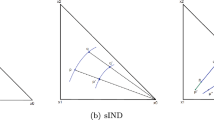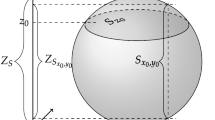Abstract
Measurement-theoretic behavior of the category of social utility models is studied in terms of ordered sums and tensor products of mixture spaces. Necessary and sufficient conditions are given for the existence of individual utility functions and a social utility function (being a weighted average, and in another case a product, of the individual utilities) in terms of individual and social preference rankings.
Similar content being viewed by others
References
Aczél, J., Lectures on Functional Equations and their Applications, Academic Press, New York, 1966.
Arrow, K., Social Choice and Individual Values, Wiley, New York, 1951, 1964.
Bourbaki, N., Espaces Vectoriels Topologiques, Hermann, Paris, 1966.
Carling, L. N., ‘Linear Inequalities and the Abstract Moment Problem in Topological Vector Spaces’, Math. Scand. 21 (1969), 221–231.
Domotor, Z., Probabilistic Relational Structures and their Applications, Tech. Rep. No. 144, Institute for Mathematical Studies in the Social Sciences, Stanford University, 1969.
Fan, K., ‘On Systems of Linear Inequalities’, in H. W. Kuhn and A. W. Tucker (eds.), Linear Inequalities and Related Systems, Princeton Univ. Press, Princeton, N.J., 1956, pp. 99–156.
Fishburn, P. C., ‘Utility Theory’, Management Science 14 (1968), 335–377.
Harsanyi, J. C., ‘Cardinal Welfare, Individualistic Ethics, and Interpersonal Comparisons of Utility’, Journal of Political Economy 63 (1955), 309–321.
Herstein, I. N. and Milnor, J., ‘An Axiomatic Approach to Measurable Utility’, Econometrica 21 (1953), 291–297.
Krantz, D. H., Luce, R. D., Suppes, P., and Tversky, A., Foundations of Measurement, Vol. I., Academic Press, New York, 1971.
Luce, R. D. and Suppes, P. C., ‘Preference, Utility and Subjective Probability’, in R. D. Luce, R. R. Bush, and E. Galanter (eds.), Handbook of Mathematical Psychology, III. Wiley, New York, 1963, pp. 250–410.
Marshak, J., ‘Rational Behavior, Uncertain Prospects, and Measurable Utility’, Econometrica 18 (1950), 111–141.
Semadeni, Z., ‘Categorical Methods in Convexity’, in Proceedings of the Colloquium on Convexity, Copenhagen, 1965, pp. 281–307.
Author information
Authors and Affiliations
Additional information
Part of the research presented here was supported by the NSF Grant GS-2936.
I am deeply indebted to Richard C. Jeffrey for his stimulation and advice, and to Duncan Luce for many valuable discussions on related topics of measurement theory.
Rights and permissions
About this article
Cite this article
Domotor, Z. Ordered sum and tensor product of linear utility structures. Theor Decis 11, 375–399 (1979). https://doi.org/10.1007/BF00139449
Issue Date:
DOI: https://doi.org/10.1007/BF00139449




